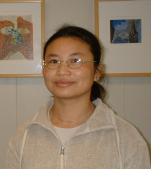Catalytic Approaches to Nanolithography
Promotion date: 26 September 2003
| The main topic in my research is nanolithography. Nanolithography is a lithographic technique to create lines or features with nanometer dimensions. To achieve this goal, we use an atomic force microscope (AFM) as the lithographic tool. The tip of the AFM is chemically modified with a catalyst, which when scanning over the surface of a catalytically active self-assembled monolayer (SAM), can catalyze the surface reaction and therefore creating patterned surfaces. The thinnest lines we managed to get with this method is 25-35 nm. |
What was your thesis about?
The main topic in my research is nanolithography. Nanolithography is a lithographic technique to create lines or features with nanometer dimensions. To achieve this goal, we use an atomic force microscope (AFM) as the lithographic tool. The tip of the AFM is chemically modified with a catalyst, which when scanning over the surface of a catalytically active self-assembled monolayer (SAM), can catalyze the surface reaction and therefore creating patterned surfaces. The thinnest lines we managed to get with this method is 25-35 nm. We tried to make different patterns apart from lines as well and also functionalize the surface chemically. This process is conceptually different from the existing technique such as dip-pen nanolithography, where pattern creation relies on the ink flow from the tip to surfaces and thus avoiding the problem of ink diffusion.
Does your research have a practical aim?
The purpose of nanofabrication covers a broad spectrum. It can be applied in computer science and also in life science, for instance in the fabrication of very small analytical tools for biological screening.
Your PHD study took a bit longer than 4 years, is there a specific reason for that?
Yes, I got pregnant and our baby boy was born. He is now 2,5 years old. It was very difficult to get day care, in the beginning we only managed to get 1,5 day per week. I had to work 5 days per week, my husband also works 5 days, so I had to take a lot of days off. At one time we even thought to send him to China to be looked after by the grandparents, but we did not want to miss anything of his development. Now he is at another day care centre, but it is very expensive.
How did you get a position in the Netherlands?
I did my master’s in chemical engineering and worked on membrane materials in China.
I joined my husband who also worked on membrane technology and did his PHD here at the UT with professor Straatmann. I arrived in March 1998, and applied with Prof. David Reinhoudt in June. In July he called me at home, asking me to come over and have a conversation with him. He informed me that they did not know anything of China and since I was also not a chemist we agreed on a small project at first. After two months he offered me my own bench in his laboratory.
What are your plans after this?
I will do some postdoctoral research with Professor Mellema here in the Physics Department, working on colloids. I shall be working with AFM again.
So you are well established here in the Netherlands, your husband has a job, your little boy is in day care. You are not in a rush to go back to China?
I like it here and am used to being here now. I like the open interaction between people as well as the professional attitude. In the short term I will stay in the Netherlands, but in the long term I would like to go back to China. I will see when the time is right.

